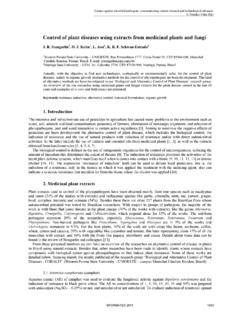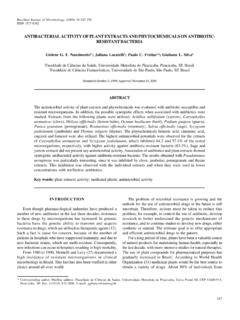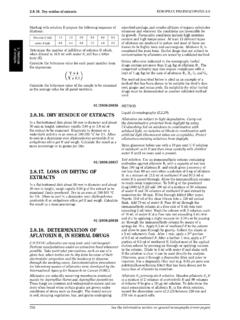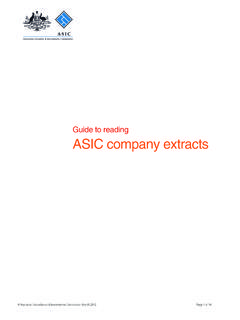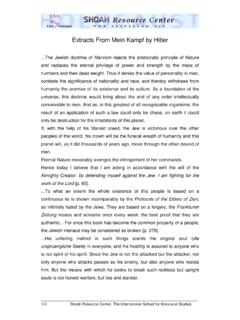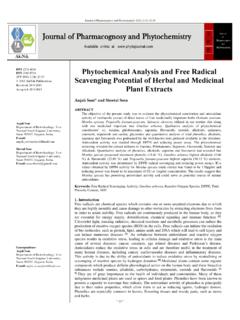Transcription of ANNATTO EXTRACTS Chemical and Technical …
1 ANNATTO EXTRACTS . Chemical and Technical Assessment First draft prepared by James Smith, Reviewed by Mrs Harriet Wallin 1. Summary The food colour ANNATTO is obtained from the outer layer of the seeds of the tropical tree Bixa orellana L. The principle pigment in ANNATTO , cis-bixin, is a carotenoid, which is contained in the resinous coating surrounding the seed itself. Processing is primarily done by abrading off of the pigment in an appropriate suspending agent for production of the native bixin from the seed. Processing may alternatively involve aqueous alkaline hydrolysis with simultaneous production of norbixin. Traditionally, water or vegetable oil is used as a suspending agent, although solvent extraction is now also employed to produce more purified ANNATTO EXTRACTS .
2 Microcrystalline bixin products of 80 - 97% purity have been developed as a response to the need for more concentrated ANNATTO EXTRACTS . ANNATTO has been used for over two centuries as a food colour especially in cheese and the various forms are now used in a wide range of food products. 2. Description ANNATTO is obtained from the outer layer of the seeds of the tropical tree Bixa orellana L. The principle pigment in ANNATTO , namely bixin, is a carotenoid, which is contained in the resinous coating surrounding the seed itself. The major pigment present is cis-bixin; also present, as minor constituents, are trans-bixin, cis-norbixin and trans-norbixin (see section on Chemical composition).
3 The ANNATTO tree is native to Central and South America where its seeds are used as a spice in traditional cooking. In Brazil, and a number of other South American countries, substantial quantities of processed ANNATTO seeds are sold in retail outlets often blended with other ingredients for addition to soups and meat dishes similar to the use of paprika seasonings in Europe. ANNATTO seeds and EXTRACTS have been used for over 200 years in Europe and North America to impart a yellow to red colour to foods, especially dairy products such as cheese. Indeed, reference is made to the colouring of cheese with ANNATTO , as far back as 1796 in England. In modern times, ANNATTO has significant economic importance worldwide and it is one of the most frequently used natural colourants of the food industry.
4 The principle export form of ANNATTO is as the seed, although to increase export values, several suppliers now also carry out partial processing / refining of ANNATTO seeds into concentrates. The main market for ANNATTO is the USA, Western Europe and Japan, although there is also considerable inter-trade (in seeds) between the Central and South American suppliers. INS number: 160b ( ANNATTO , bixin, norbixin). Common synonyms: CI Natural Orange 4; CI 75120. Achiote, Achiotl, Achote, Annotta, Arnatta, Arnatto, Arnotta, Bija, Rocou, Roucou, Roucouyer, Roucoyer, Orlean, Orleanstraugh, Terre orellana, Beni-No-Ki, Urucu, Urucum, L. Orange ANNATTO EXTRACTS (CTA) 2006 - Page 1(21). Number ANNATTO : 1393-63-1.
5 Bixin: 39937-23-0 (trans). 39937-79-5 (cis). Norbixin: 542-40-5 (trans). 626-76-6 (cis). ANNATTO is native to tropical America, where it has been a traditional part of some foods for centuries, but is also cultivated in Asia and Africa, especially in areas where coffee is grown. The ANNATTO plant, Bixa orellana L, is a tree that grows from two to five meters tall when mature. The fruits of the tree Bixa orellana L consist of a pod covered with fleshy spines, varying in size and shape. The inside of the pod is usually divided into two valves containing between ten to fifty small seeds. These seeds are covered with a resinous orange or red coating (arils) from which the commercial pigment is extracted.
6 Harvesting is manual whereby workers cut off the ends of branches that contain the seed pods. Such pruning of the branches seems to help increase seed production in the plant. The dried pods are threshed and winnowed to remove pod material and other detritus thereby releasing the seeds. The seeds subsequently are then dried and packaged for shipment. Although ANNATTO seed is harvested in many tropical countries including Bolivia, Ecuador, Jamaica, the Dominican Republic, East & West Africa (Kenya), India and the Philippines, it is Peru and Brazil that are the dominant sources of supply. The quantity of ANNATTO seed harvested in the producing countries is estimated at 14,500 metric tonnes (Table 1).
7 It is likely that around 7,500 tonnes of ANNATTO seed are used annually as a food colour worldwide and, assuming an average colour content of 2%, this equates to 150 tonnes of bixin available for extraction. The remaining 7,000 metric tonnes of ANNATTO seed is consumed locally in Brazil, Peru and Ecuador mainly as a spice / condiment. ANNATTO EXTRACTS (CTA) 2006 - Page 2(21). Table 1. Estimated World Production (in Metric Tonnes) of ANNATTO seed*. PRODUCERS IMPORTERS. Brazil 5,000 (either as seed or its equivalent in extract). Peru Ecuador North America 3,000. Colombia Europe 2,500. Bolivia 3,000 Japan 1,500. Other 500. Kenya _____. Tanzania 2,500 Total 7,500. Guatemala Mexico Caribbean 2,000.
8 Ivory Coast Ghana 1,500. India, Asia 500. _____. Total 14,500. Of which: Domestic consumption** 7,000. Available for export 7,500. _____. 14,500. * Adapted from UNCTAD / GATT (1990), Wood et al. (1991), Green et al. (1995) and Dinesen (1999). ** within the producer countries. ANNATTO EXTRACTS (CTA) 2006 - Page 3(21). 3. Manufacturing Manufacturing principle Commercial production occurred in Jamaica in the 1790s. In Europe and the US, production of commercial EXTRACTS started before the 1870s, primarily to colour butter and cheese. As the bixin pigment is found in the aril (outer waxy coat) of the seed, the processing includes abrading or raspelling (mechanical removal of the aril from the seed) of the pigment in an appropriate suspending agent followed by removal of the seeds.
9 For the purposes of removing the pigment, it is not necessary to grind the seed. Processing methods may either be aimed at the production of the native bixin from the seed or may involve aqueous alkaline hydrolysis and simultaneous production of norbixin. Solvent extraction techniques are now also used as a means of production of ANNATTO concentrates. Detailed description ANNATTO seeds may be processed in two fundamentally different ways. One process is mechanical abrasion using either vegetable oil or dilute aqueous potassium hydroxide as a suspending agent. Further direct processing of these EXTRACTS may then be undertaken (Figure 1). The other process is by extraction with one or more organic solvents.
10 These two commonly used processing methods are outlined below. Mechanical Abrasion: Extraction with refined vegetable oil Oil processing usually involves mechanical methods using edible vegetable oil whereby the ANNATTO seeds are massaged in warm oil ( 700C) to remove the pigment layer in a machine sometimes called a 'Raspeller'. The resulting suspensions contain bixin as the primary pigment at a concentration up to 8%. It is common to see ANNATTO oil preparations presented commercially as suspensions containing between 4 - 8% bixin. There is evidence of some proprietary technology utilizing propylene glycol in place of vegetable oil as a suspending agent for ANNATTO seeds, however the volumes involved are small.










